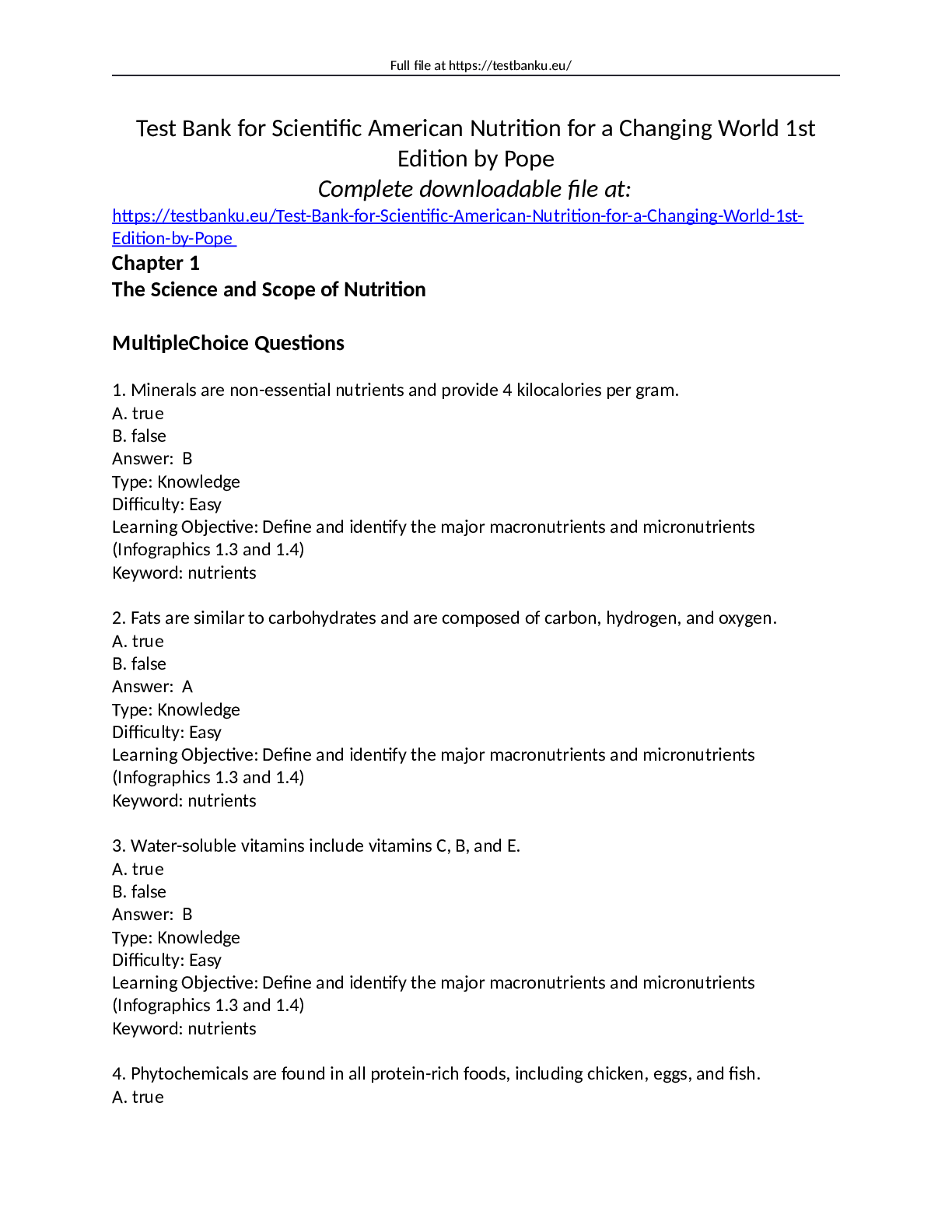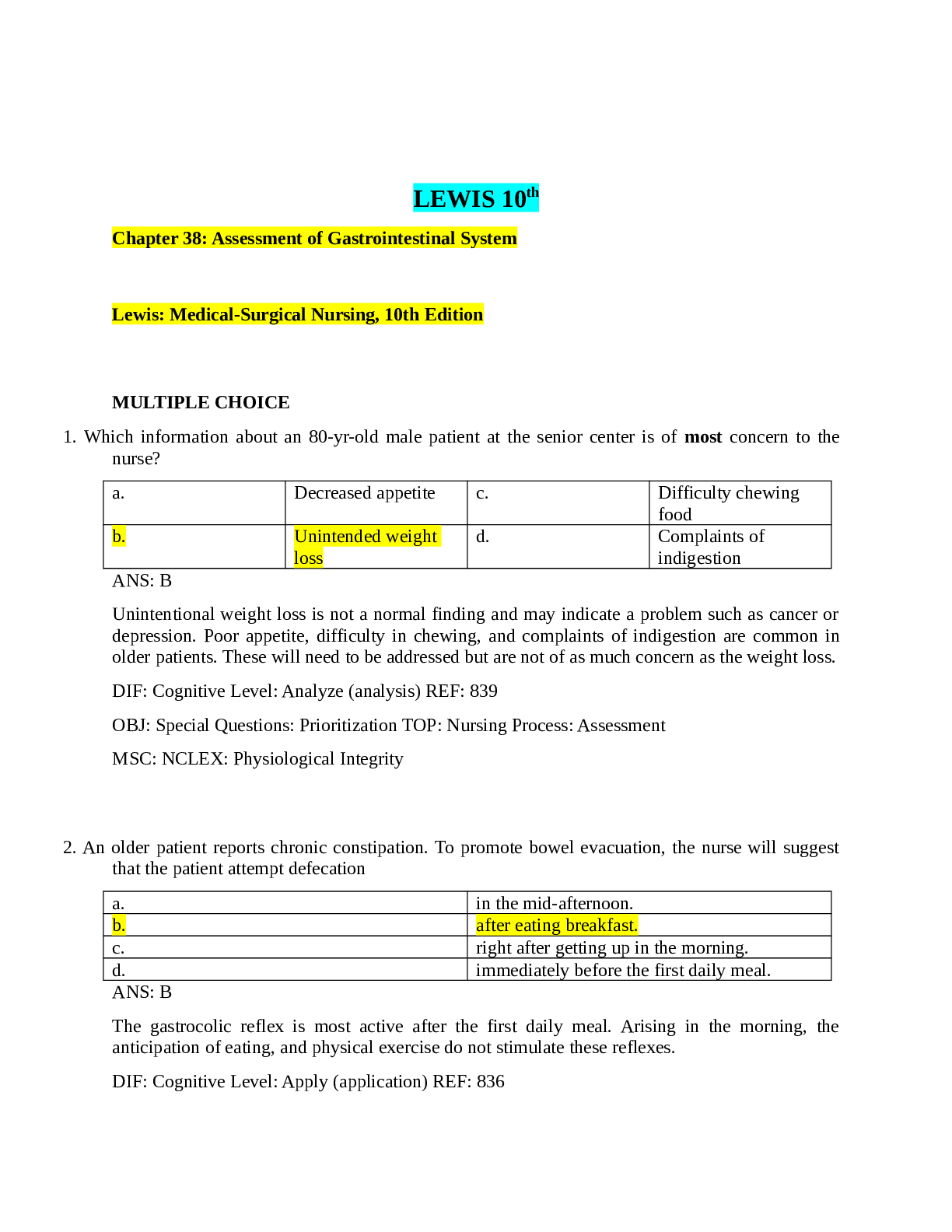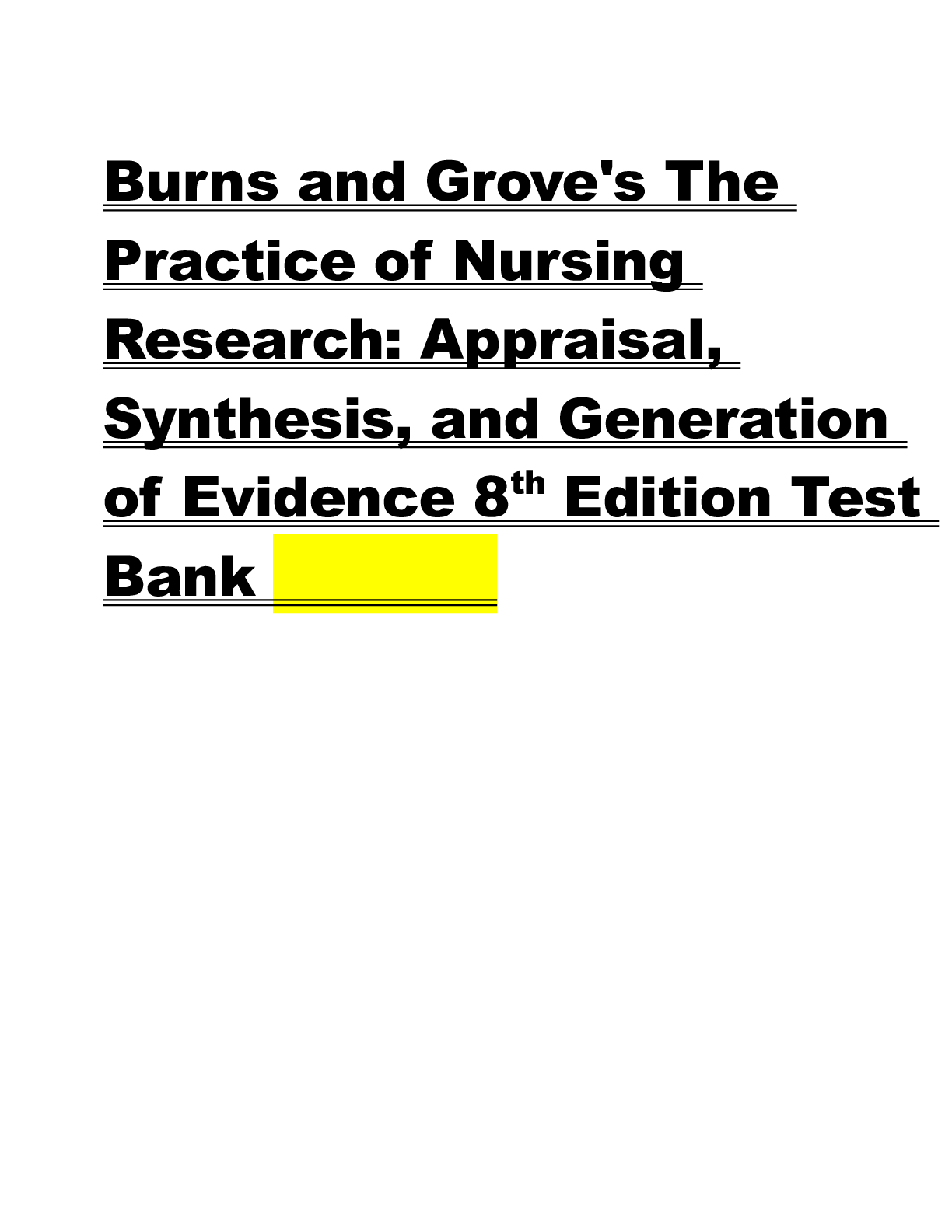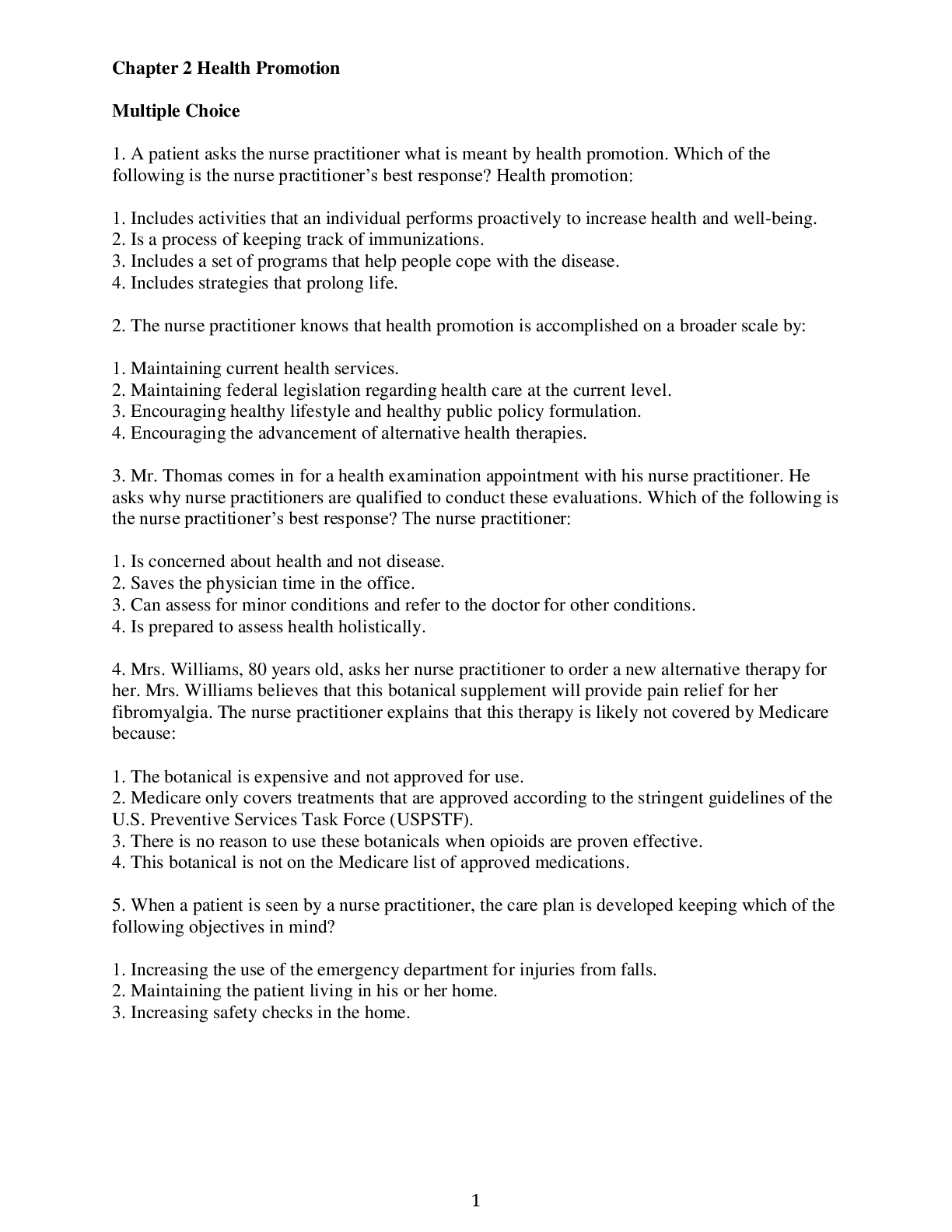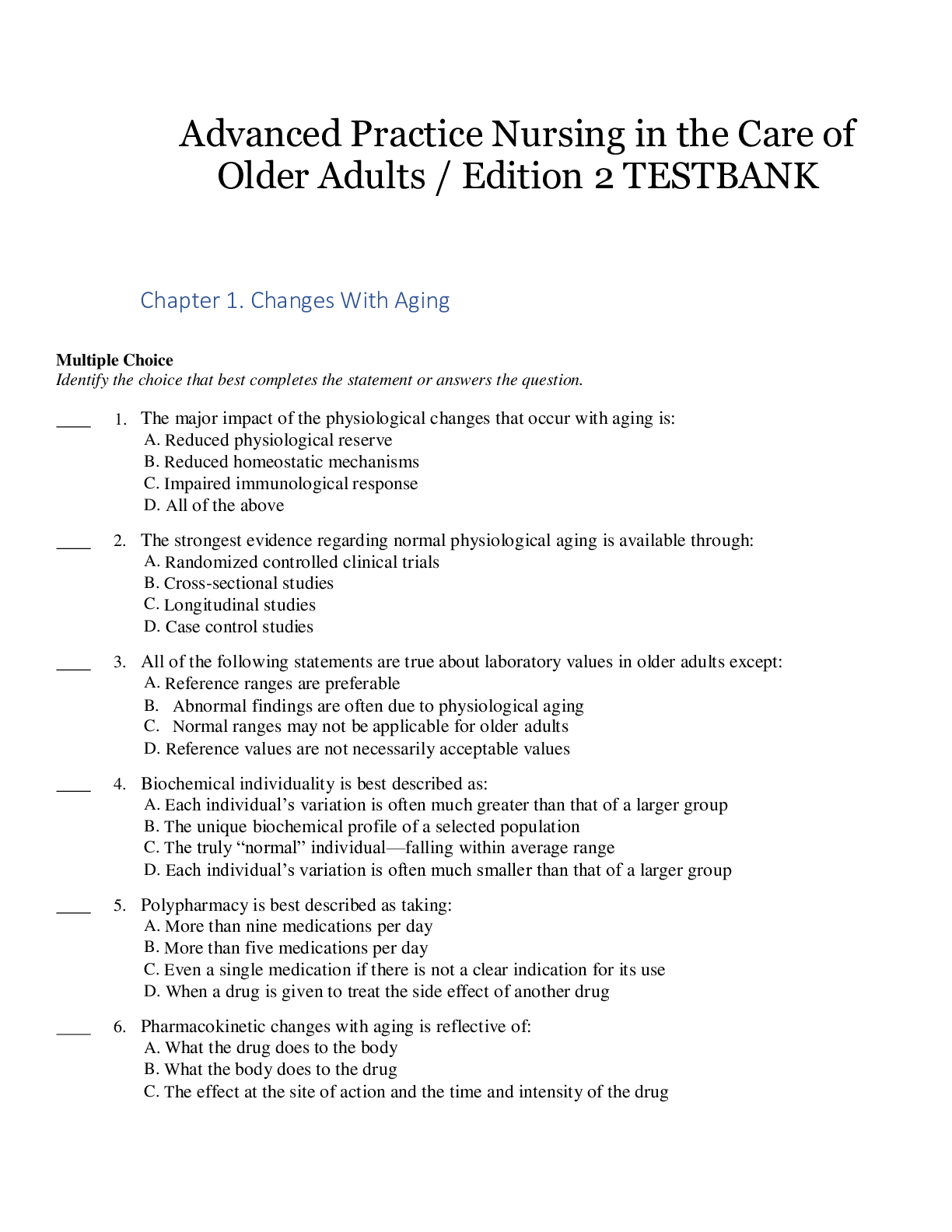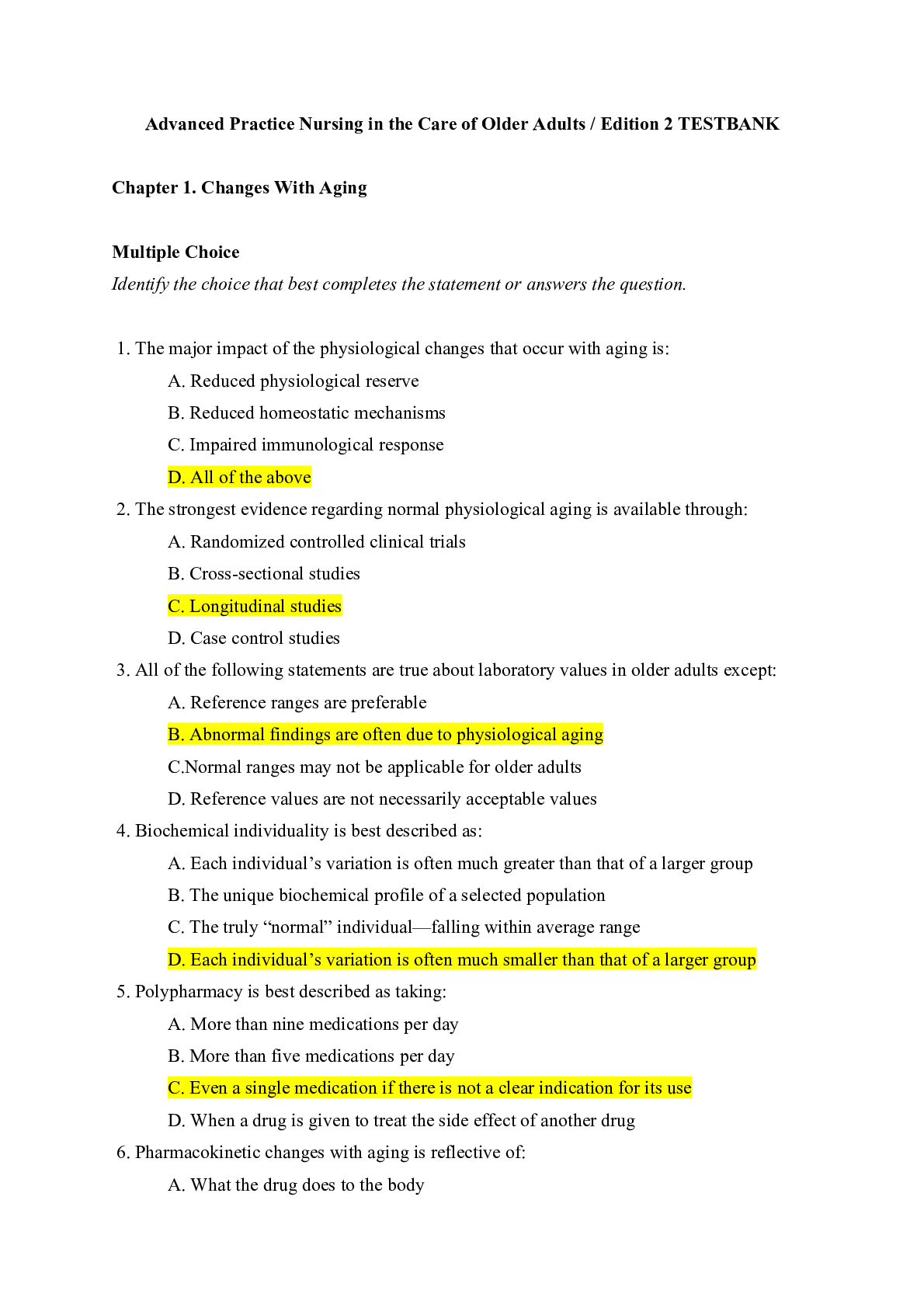*NURSING > TEST BANK > Advanced Practice Nursing in the Care of Older Adults /2nd Edition TESTBANK (All)
Advanced Practice Nursing in the Care of Older Adults /2nd Edition TESTBANK
Document Content and Description Below
Chapter 1. Changes With Aging Multiple Choice Identify the choice that best completes the statement or answers the question. 1. The major impact of the physiological changes that occur with aging ... is: A. Reduced physiological reserve B. Reduced homeostatic mechanisms C. Impaired immunological response D. All of the above 2. The strongest evidence regarding normal physiological aging is available through: A. Randomized controlled clinical trials B. Cross-sectional studies C. Longitudinal studies D. Case control studies 3. All of the following statements are true about laboratory values in older adults except: A. Reference ranges are preferable B. Abnormal findings are often due to physiologicalaging C. Normal ranges may not be applicable for olderadults D. Reference values are not necessarily acceptable values 4. Biochemical individuality is best described as: A. Each individual’s variation is often much greater than that of a larger group B. The unique biochemical profile of a selected population C. The truly “normal” individual—falling within average range D. Each individual’s variation is often much smaller than that of a larger group 5. Polypharmacy is best described as taking: A. More than nine medications per day B. More than five medications per day C. Even a single medication if there is not a clear indication for its use D. When a drug is given to treat the side effect of another drug 6. Pharmacokinetic changes with aging is reflective of: A. What the drug does to the body B. What the body does to the drug C. The effect at the site of action and the time and intensity of the drug D. The side effects commonly associated with the drug 7. All the following statements are false about drug absorption except: A. Antacids increase the bioavailability ofdigitalis B. Gastric acidity decreases withage C. Anticholinergics increase colonicmotility D. Underlying chronic disease has little impact on drugabsorption 8. All of the following statements are true about drug distribution in the elderly except: A. Drugs distributed in water have lowerconcentration B. Drugs distributed in fat have less intense, more prolongedeffect C. Drugs highly protein bound have greater potential to cause an adversedrug reaction D. The fastest way to deliver a drug to the action site is byinhalation 9. Men have faster and more efficient biotransformation of drugs and this is thought to be due to: A. Less obesity rates thanwomen B. Prostateenlargement C. Testosterone D. Less estrogen thanwomen 10. The cytochrome p system involves enzymes that are generally: A. Inhibited bydrugs B. Induced bydrugs C. Inhibited or induced bydrugs D. Associated with decreased liverperfusion 11. A statement not shown to be true about pharmacodynamics changes with aging is: A. Decreased sensitivity to oralanticoagulants B. Enhanced sensitivity to central nervous systemdrugs C. Drug responsiveness can be influenced by patient activitylevel D. There is a decreased sensitivity to betablockers 12. Atypical presentation of disease in the elderly is reflected by all the following except: A. Infection withoutfever B. Depression without dysphoricmood C. Myocardial infarction with chest pain anddiaphoresis D. Cardiac manifestations of thyroid disease 13. Functional abilities are best assessed by: A. Self-report of function B. Observed assessment offunction C. A comprehensive head-to-toeexamination D. Family report offunction Chapter 2. Health Promotion Multiple Choice Identify the choice that best completes the statement or answers the question. 1. The leading cause of death in elderly travelers worldwideis: A. Cardiovasculardisease B. Infections C. Accidents D. Malaria 2. Which of the following should be avoided in countries where food and water precautions are to be observed? A. Hotcoffee B. Bottledwater C. Saladbuffet D. Unpeeledbananas 3. What insect precautions are not necessary to prevent insect-borne diseases in thetropics? A. Using 100% DEET on skin to preventbites B. Treating clothes withpermetherin C. Covering up exposed skin to lessen bitingsurface D. Taking malaria pills as directed for areas at risk formalaria 4. An example of secondary prevention you could recommend/order for older adults would beto: A. Check for fecal occultblood B. Wear seat belts in thecar C. Provide foot care for a diabeticpatient D. Administer a tetanusshot 5. Ali is a 72-year-old man who recently came to the U.S. from Nigeria. He reports having BCG (bacille Calmette-Guerin) vaccination as a child. Which of the following is correct regarding a tuberculin skin test? A. It should not be done atall. B. Itshould be read as smaller than it reallyis. C. Vaccination history is irrelevant; read as usual. D. It should be read as larger than it reallyis. 6. A 72-year-old woman and her husband are on a cross-country driving vacation. After a long day of driving, they stop for dinner. Midway through the meal, the woman becomes very short of breath, with chest pain and a feeling of panic. Which of the following problems is mostlikely? A. Pulmonaryedema B. Heartfailure C. Pulmonaryembolism D. Pneumonia 7. Ivan W. is a 65-year-old man who is new to your practice. He has a history of COPD, CAD, hypertension, and type 2 diabetes mellitus. He has had no immunizations since his discharge from the military at age 25. Childhood diseases included chickenpox, measles, mumps, and “German measles.”Hepresentsforadisease management visit.Whichofthefollowingimmunizationswould you recommend forIvan? A. MMR, influenza, pneumococcal,Zostavax B. Influenza, pneumococcal, PPD, HepatitisB C. Tdap, pneumococcal, influenza,Zostavax D. Hepatitis B, influenza, pneumococcal, HepatitisA 8. Leo L. is a 62-year-old African American male who comes for an initial visit to yourpractice. Personal health history includes smoking 1 pack/day since age 11, consuming a case of beer (24 bottles) every weekend, and working as an assembler (sedentary job) for the past 10 years. Family history in first-degree relatives includes hypertension, high cholesterol, heart attack, and type 2 diabetes mellitus. Leo’s BMI is 32; BP today is 130/86. You order a fasting glucose, lipid profile, and return visit for BP check. This is an example of: A.Primaryprevention B.Secondaryprevention C.Tertiaryprevention D.Healthprofiling 9. A local chapter of a nurse practitioner organization has begun planning a community-based screening for hypertension at a local congregate living facility. This population was selected onthe basisof: A. A predicted decreased incidence of high blood pressurein thispopulation B. A recognized element of high risk within thisgroup C. Readily available treatmentmeasures D. Achieving an administrative goal for the congregate livingfacility 10. Performing range of motion exercises on a client who has had a stroke is an example of which level of prevention? A. Primary prevention B. Tertiary prevention C. Secondary prevention D. Rehabilitation prevention 11. The nurse practitioner demonstrates an understanding of primary prevention of falling among the elderly through which managementplan? A. Evaluate a need for assistive devices for ambulation after the client hasbeen injured from afall. B. Provide resources to correct hazards contributing to falls in the homeenvironment. C. Reinforce the need to use prescribed eyeglasses to prevent further injury from falls. D. Provide information about medications, side effects, andinteractions. 12. An example of an active strategy of health promotion for an individual to accomplish wouldbe: A. Maintaining clean water in the local environment B. Introducing fluoride into thewater C. Beginning a stress managementprogram D. Maintaining a sanitary sewage system 13. You are working with an older male adult with a long history of alcohol abuse and a 30-year history of smoking. In recommending an intervention for this client, your responsibility isto: A. Make the individual abandon his own health practices and follow your nkrecommendations B. Register the patient for a local intervention program and secure payments C. Promote positive change in lifestylechoice D. Identify the barriers that the client willencounter 14. The four main domains of clinical preventive services that the practitioner will provide are: A. Counseling interventions, screening tests, immunizations, andchemoprophylaxis B. Counseling intervention, screening tests, immunizations, andeducation C. Counseling interventions, transportation, screening tests,and immunizations D. Screening tests, brief psychotherapy, immunizations, andchemoprophylaxis 15. Which organism that can be prevented by immunization is most often responsible for an infectious “outbreak” in the nursing home setting? A. Haemophilusinfluenza B. Streptococcus C. Influenza A D. Mycobacteriumtubercu [Show More]
Last updated: 1 year ago
Preview 1 out of 70 pages
Instant download
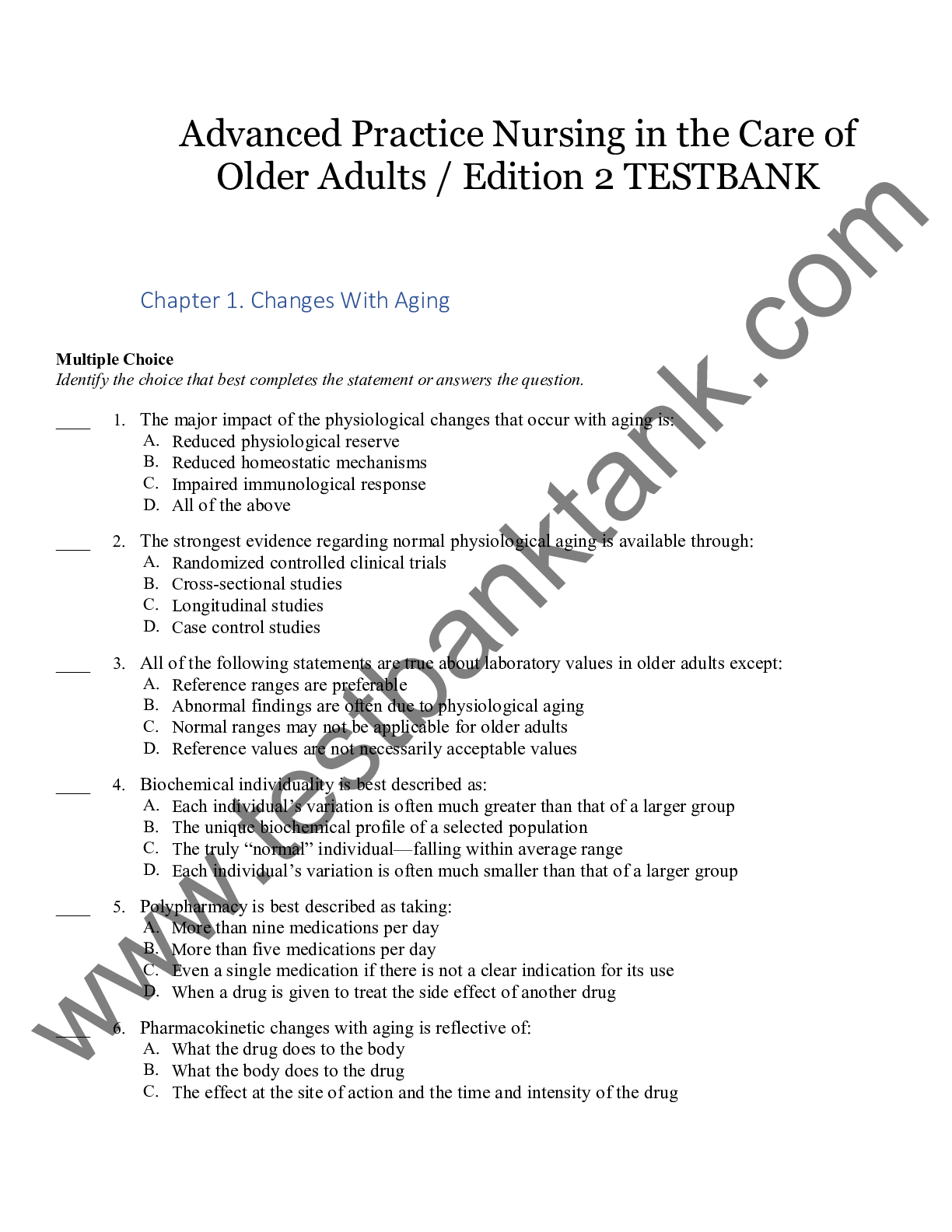
Buy this document to get the full access instantly
Instant Download Access after purchase
Add to cartInstant download
Reviews( 0 )
Document information
Connected school, study & course
About the document
Uploaded On
May 03, 2022
Number of pages
70
Written in
Additional information
This document has been written for:
Uploaded
May 03, 2022
Downloads
0
Views
66

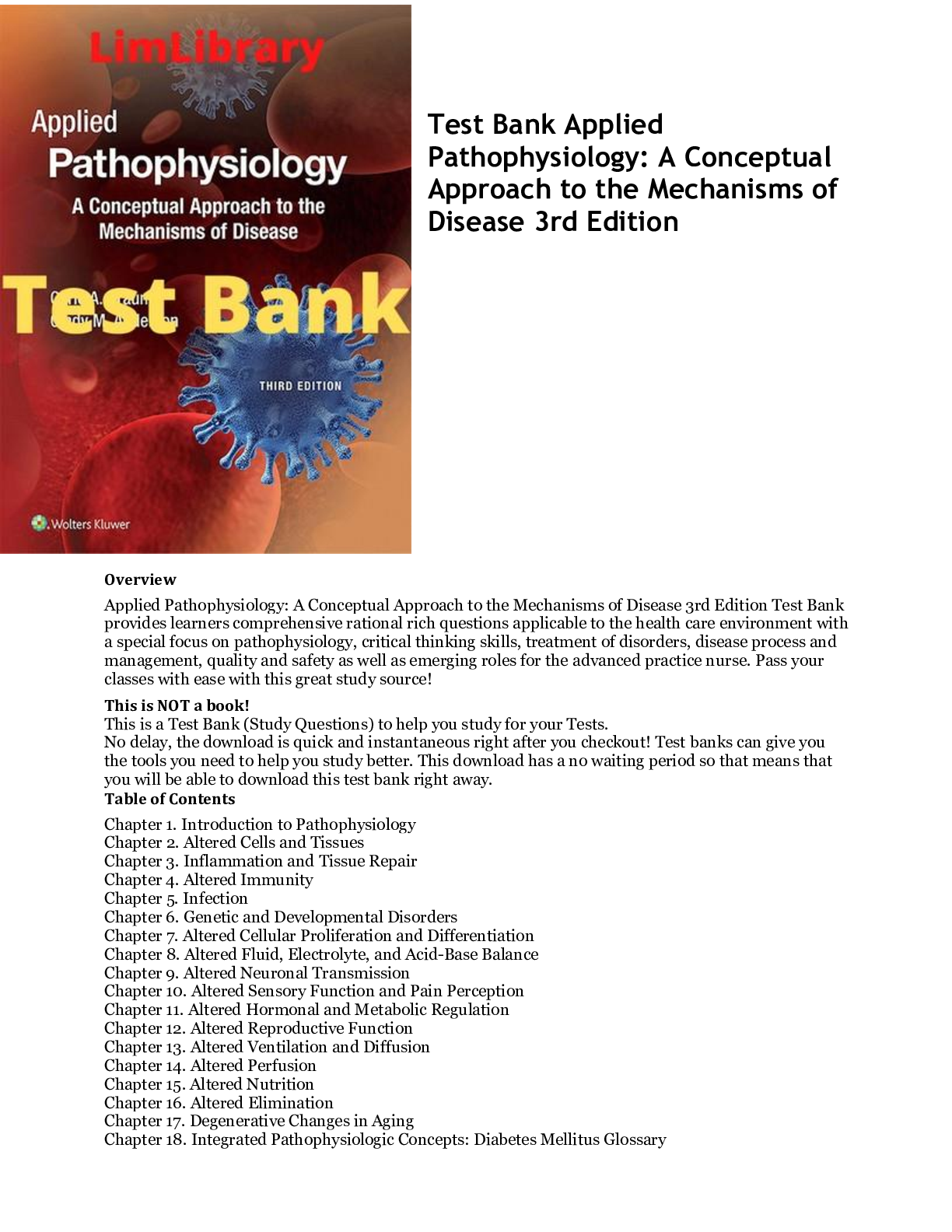

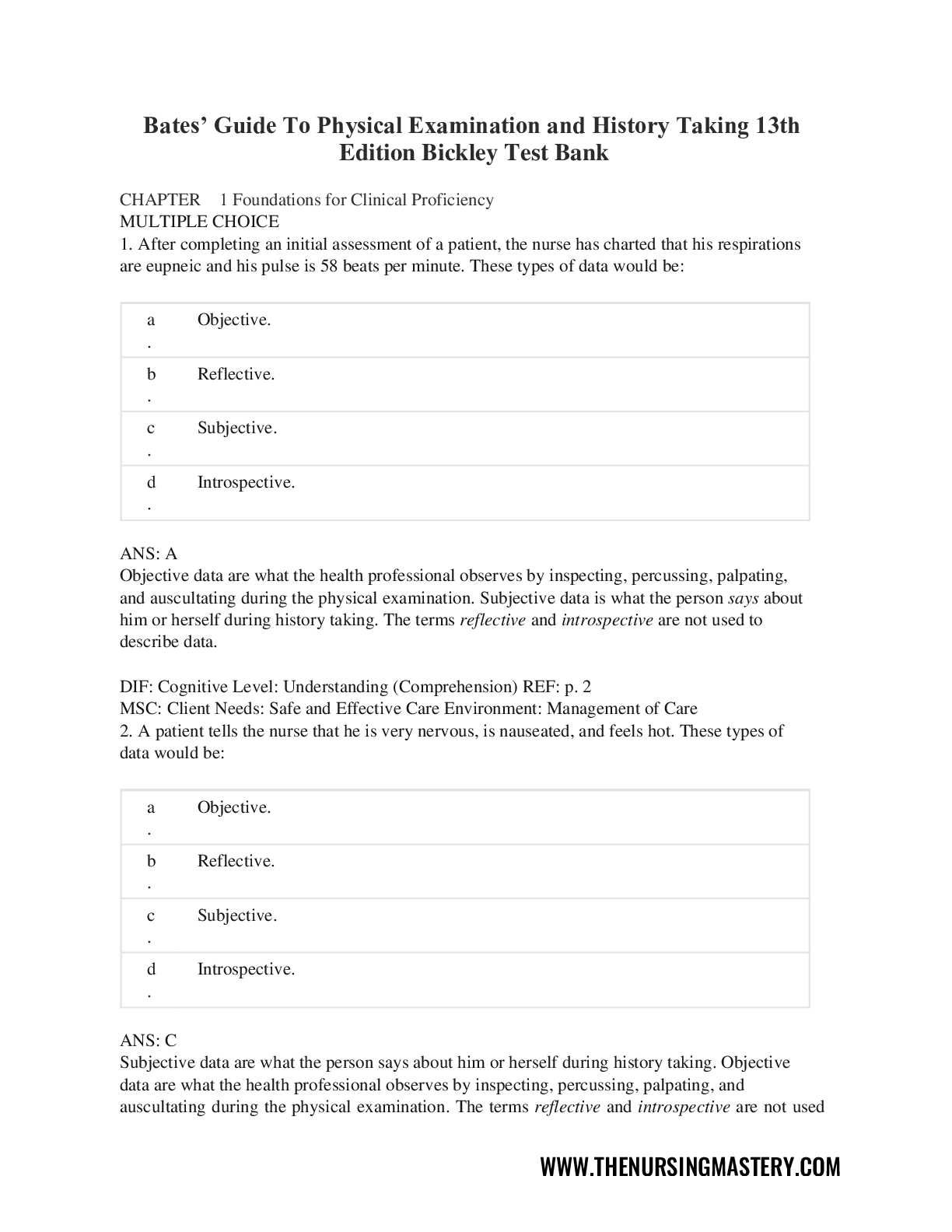
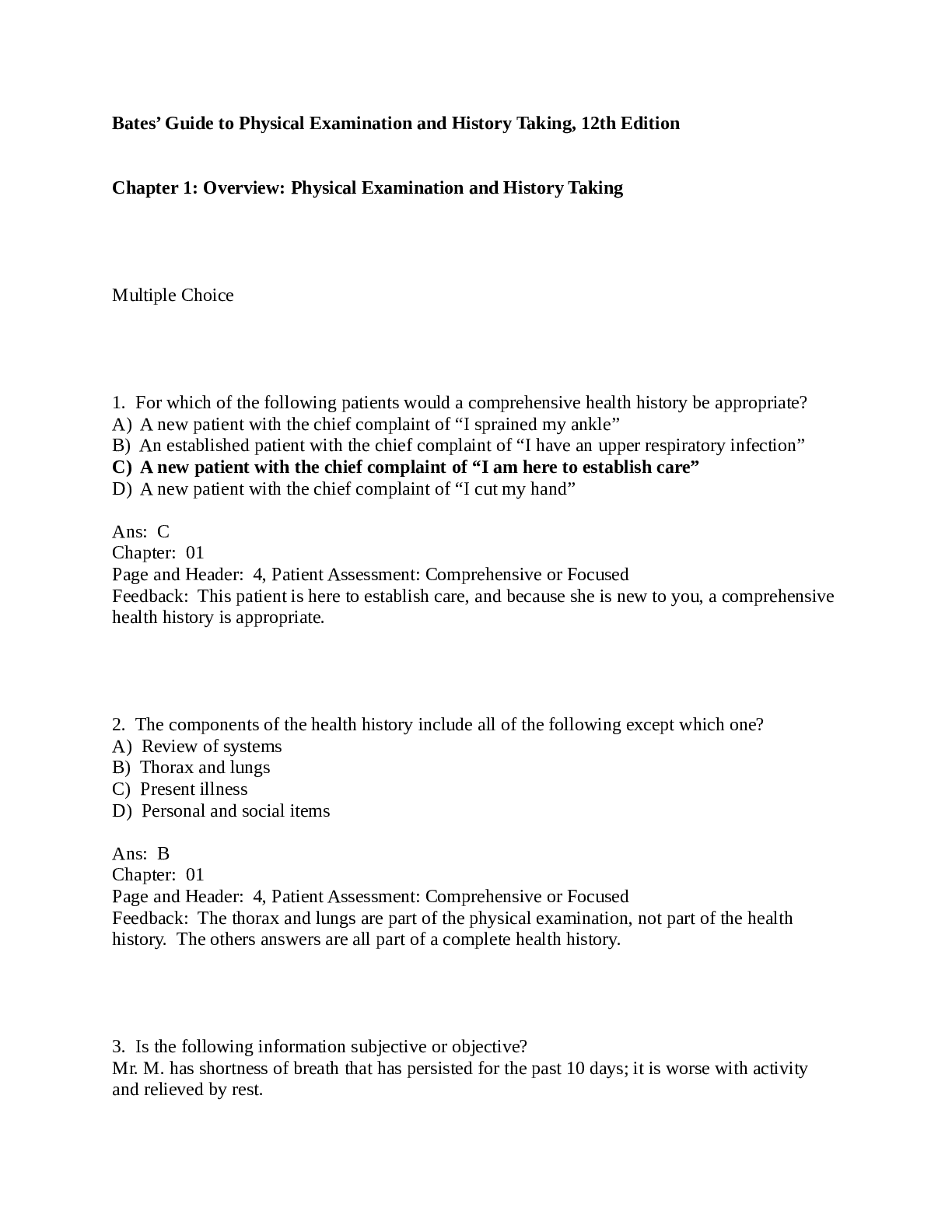
.png)
.png)
.png)

